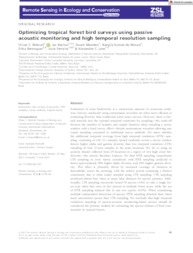Optimizing tropical forest bird surveys using passive acoustic monitoring and high temporal resolution sampling.
Optimizing tropical forest bird surveys using passive acoustic monitoring and high temporal resolution sampling.
Author(s): METCALF, O. C.; BARLOW, J.; MARSDEN, S.; MOURA, N. G. de; BERENGUER, E.; FERREIRA, J. N.; LEES, A. C.
Summary: Estimation of avian biodiversity is a cornerstone measure of ecosystem condition. Surveys conducted using autonomous recorders are often more efficient at estimating diversity than traditional point-count surveys. However, there is limited research into the optimal temporal resolution for sampling-the trade-off between the number of samples and sample duration when sampling a survey window with a fixed survey effort-despite autonomous recorders allowing easy repeat sampling compared to traditional survey methods. We assess whether the additional temporal coverage from high temporal resolution (HTR) sampling, consisting of 240 15-s samples spread randomly across a survey window detects higher alpha and gamma diversity than low temporal resolution (LTR) sampling of four 15-min samples at the same locations. We do so using an acoustic dataset collected from 29 locations in a region of very high avian biodiversity-the eastern Brazilian Amazon. We find HTR sampling outperforms LTR sampling in every metric considered, with HTR sampling predicted to detect approximately 50% higher alpha diversity, and 10% higher gamma diversity. This effect is primarily driven by increased coverage of variation in detectability across the morning, with the earliest period containing a distinct community that is often under sampled using LTR sampling. LTR sampling produced almost four times as many false absences for species presence. Additionally, LTR sampling incorrectly found 70 species (34%) at only a single forest type when they were in fact present in multiple forest types, while the use of HTR sampling reduced this to just two species (0.9%). When considering multiple independent detections of species, HTR sampling detected three times more uncommon species than LTR sampling. We conclude that high temporal resolution sampling of passive-acoustic monitoring-based surveys should be considered the primary method for estimating the species richness of bird communities in tropical forests.
Publication year: 2022
Types of publication: Journal article
Unit: Embrapa Eastern Amazon
Keywords: Ave Selvagem, Bioacustica, Floresta Tropical, Tropical forests
Observation
Some of Embrapa's publications are published as ePub files. To read them, use or download one of the following free software options to your computer or mobile device. Android: Google Play Books; IOS: iBooks; Windows and Linux: Calibre.
Access other publications
Access the Agricultural Research Database (BDPA) to consult Embrapa's full library collection and records.
Visit Embrapa Bookstore to purchase books and other publications sold by Embrapa.

